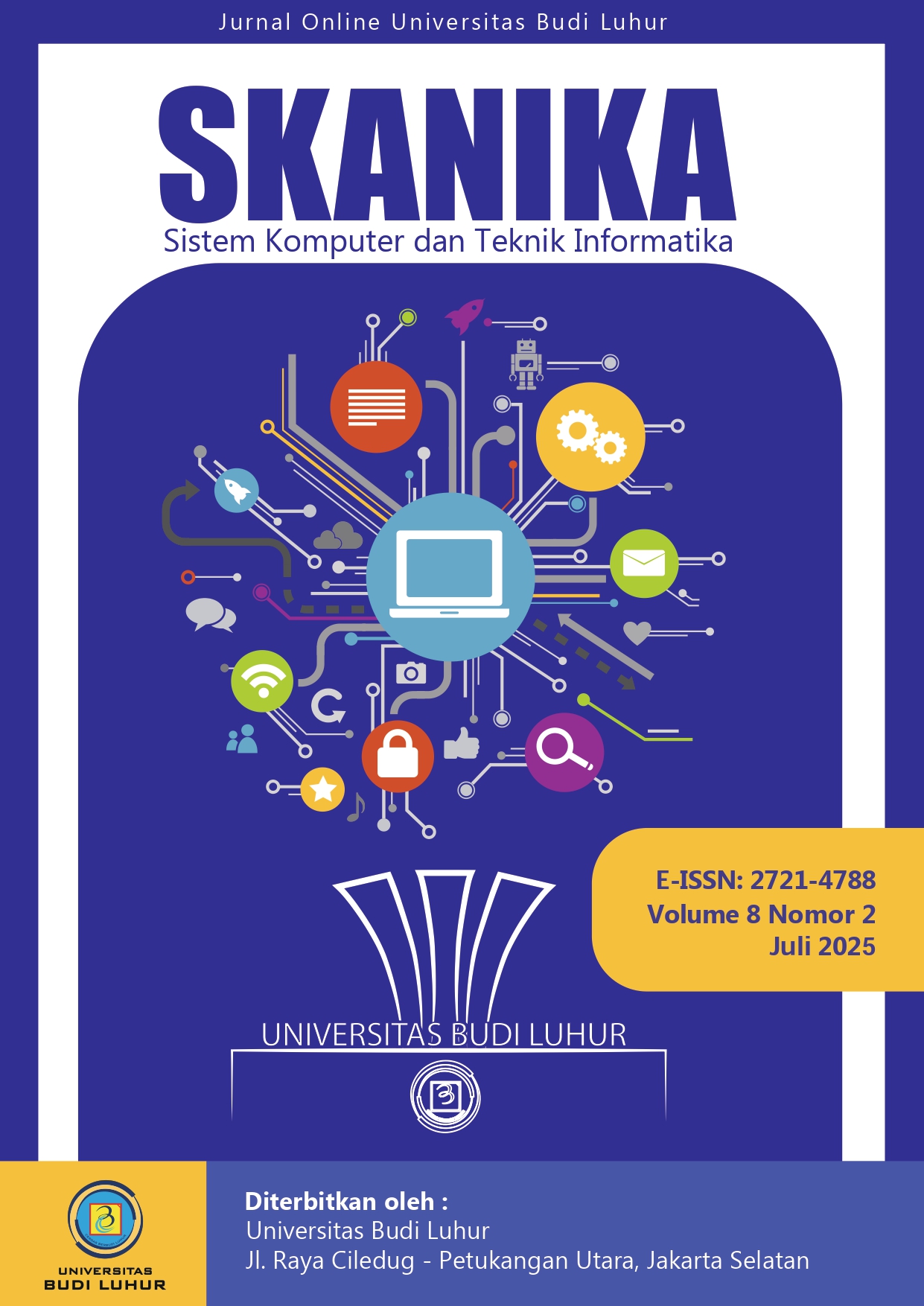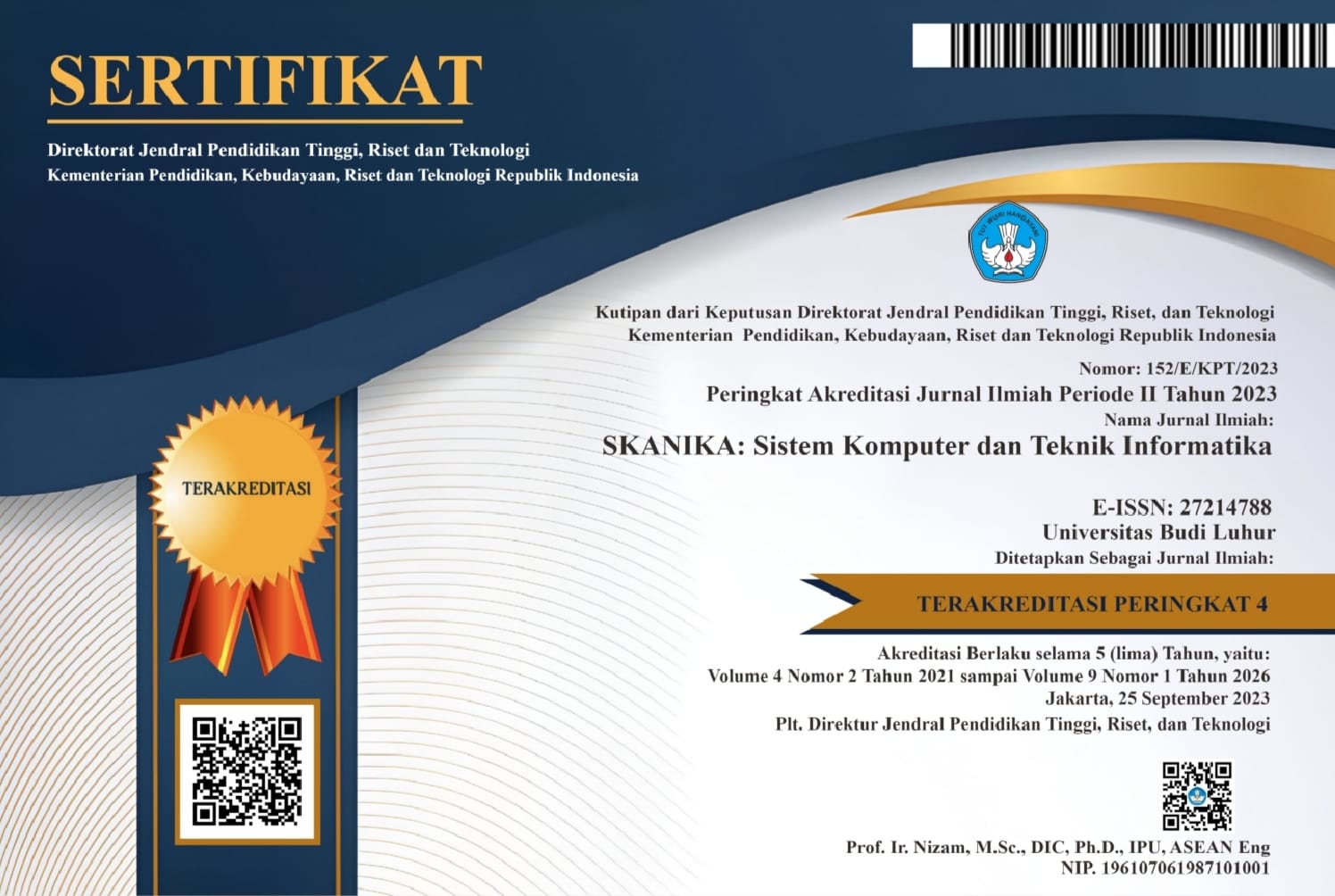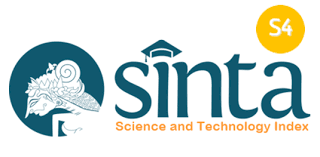IMPLEMENTASI ALGORITMA CLUSTERING DBSCAN TERHADAP POLA NAVIGASI PENGGUNA DI PERPUSTAKAAN DIGITAL UNTUK MENGUNGKAP ZONA BUTA AKSES INFORMASI DAN OPTIMALISASI ANTARMUKA SISTEM
DOI:
https://doi.org/10.36080/skanika.v8i2.3524Keywords:
DBSCAN Algorithm, System Interface Optimization, Digital Library, User Navigation Pattern, Information Access Blind ZoneAbstract
Advances in information technology have encouraged the transformation of libraries to digital form, increasing accessibility, but not all collections can be reached equally by users. This study aims to identify user navigation patterns and information access blind zones in the INLISLite digital library system using the DBSCAN clustering algorithm. Simulation log data representing common user exploration sessions were analyzed through the stages of one-hot representation, density-based clustering, and two-dimensional visualization with PCA. The results showed the formation of six main clusters with different navigation behavior characteristics and 15% of the sessions were classified as outliers. Pages such as “Advanced Search” and “Favorites” were detected as blind zones because they were not reached in most sessions. These findings indicate a failure of the interface to bridge users to the entire spectrum of information. Recommendations of navigation redesign, contextual pop-up of hidden content, and adaptive interface approaches were proposed as solutions. The DBSCAN-based approach proved effective for evaluating the effectiveness of digital information systems in terms of user behavior, and has the potential to be applied in the development of more responsive and inclusive digital libraries.
Downloads
References
[1] E. Purificato, L. Boratto, and E. W. De Luca, “User Modeling and User Profiling: A Comprehensive Survey,” arXiv:2402.09660v2, pp. 2–71, 2024, doi: https://doi.org/10.48550/arXiv.2402.09660.
[2] R. Kaur et al., “E-Learning Environment Based Intelligent Profiling System for Enhancing User Adaptation,” Electronics (Switzerland), vol. 11, no. 20, pp. 1–16, 2022, doi: 10.3390/electronics11203354.
[3] Y. Mo and H. Wang, “Session-Based Recommendation Method Using Popularity-Stratified Preference Modeling,” Mathematics, vol. 13, no. 6, pp. 1–16, 2025, doi: 10.3390/math13060960.
[4] M. Kuhar and T. Merčun, “Exploring user experience in digital libraries through questionnaire and eye-tracking data,” Library and Information Science Research, vol. 44, no. 3, pp. 1–11, 2022, doi: 10.1016/j.lisr.2022.101175.
[5] S. Lewis, “Cluster analysis as a technique to guide interface design,” International Journal of Man-Machine Studies, vol. 35, no. 2, pp. 251–265, 1991, doi: https://doi.org/10.1016/S0020-7373(05)80151-8.
[6] A. P. Narendra, C. Dewi, L. S. Gunawan, and A. S. Ardi, “Artificial Intelligence Implementation in Library Information Systems: Current Trends and Future Studies,” Vietnam Journal of Computer Science, pp. 1–25, 2024, doi: 10.1142/S2196888824300023.
[7] T. Dinh et al., “Data clustering: an essential technique in data science,” arXiv:2412.18760v2, pp. 1–17, Jan. 2025, doi: https://doi.org/10.48550/arXiv.2412.18760.
[8] L. Gaur et al., “Medical image-based detection of COVID-19 using Deep Convolution Neural Networks,” in Multimedia Systems, Springer Science and Business Media Deutschland GmbH, pp. 1729–1738, 2023. doi: 10.1007/s00530-021-00794-6.
[9] L. Chirinos-Apaza, “Identification of crowds using mobile crowd detection (MCS) and visualization with the DBSCAN algorithm for a Smart Campus environment,” arXiv: 2410.12797v1, pp. 1–12, 2024.
[10] H. Liu, Y. Liu, Z. Qin, R. Zhang, Z. Zhang, and L. Mu, “A Novel DBSCAN Clustering Algorithm via Edge Computing-Based Deep Neural Network Model for Targeted Poverty Alleviation Big Data,” Wireless Communications and Mobile Computing, vol. 2021, pp. 1–10, 2021, doi: 10.1155/2021/5536579.
[11] G. Mo, S. Song, and H. Ding, “Towards Metric DBSCAN: Exact, Approximate, and Streaming Algorithms,” in Proceedings of the ACM on Management of Data, New York, NY, USA: Association for Computing Machinery, pp. 1-25, 2024. doi: 10.1145/3654981.
[12] Y. Xie et al., “Significant DBSCAN+: Statistically Robust Density-based Clustering,” ACM ACM Transactions on Intelligent Systems and Technology, vol. 12, no. 5, pp. 1-26, 2021, doi: 10.1145/3474842.
[13] T. Ouyang and X. Shen, “Online structural clustering based on DBSCAN extension with granular descriptors,” Information Sciences, vol. 607, pp. 688–704, 2022, doi: https://doi.org/10.1016/j.ins.2022.06.027.
[14] S. Shin, I. Shomorony, and P. Macgregor, “Dynamic DBSCAN with Euler Tour Sequences,” in Proceedings of The 28th International Conference on Artificial Intelligence and Statistics, vol. 258, PMLR, 2025, pp. 1495–1503.
[15] P. Artioli, A. Maci, and A. Magrì, “A comprehensive investigation of clustering algorithms for User and Entity Behavior Analytics,” Front Big Data, vol. 7, pp. 1-25, 2024, doi: 10.3389/fdata.2024.1375818.
[16] V. Zabiniako, T. Rožkalns, E. Nazaruka, and J. Kornienko, “Analysis of Algorithms for Detecting Users’ Behavioral Models based on Sessions Data,” Complex Systems Informatics and Modeling Quarterly, vol. 2024, no. 41, pp. 55–79, 2024, doi: 10.7250/csimq.2024-41.04.
[17] M. Begum et al., “M-DBSCAN: Modified DBSCAN Clustering Algorithm for Detecting and Controlling Outliers,” in Proceedings of the 39th ACM/SIGAPP Symposium on Applied Computing, in SAC ’24. New York, NY, USA: Association for Computing Machinery, 2024, pp. 1034–1035. doi: 10.1145/3605098.3636188.
[18] H. Peng, X. Huang, S. Sun, R. Zhang, and P. S. Yu, “Adaptive and Robust DBSCAN with Multi-agent Reinforcement Learning,” arXiv preprint arXiv:2505.04339, pp. 1-36, 2025, doi: https://doi.org/10.48550/arXiv.2505.04339.
[19] U. Kazemi and S. Soleimani, “Combination of Density-Based Spatial Clustering with Grid Search Using Nash Equilibrium,” Engineering Reports, vol. 7, no. 3, pp. 1–15, 2025, doi: 10.1002/eng2.70037.
[20] L. Li and K. Yu, “Application of Improved HF-DBSCAN Algorithm in Analyzing Complex Trajectory Data of Wi-Fi Users in Smart Campus,” Applied Artificial Intelligence, vol. 38, no. 1, 2024, doi: 10.1080/08839514.2024.2403260.
Downloads
Published
How to Cite
Issue
Section
License
Copyright (c) 2025 Sherly Rosa Anggraeni

This work is licensed under a Creative Commons Attribution-ShareAlike 4.0 International License.
CC BY-SA 4.0
Creative Commons Attribution-ShareAlike 4.0 International
This license requires that reusers give credit to the creator. It allows reusers to distribute, remix, adapt, and build upon the material in any medium or format, even for commercial purposes. If others remix, adapt, or build upon the material, they must license the modified material under identical terms.
BY: Credit must be given to you, the creator.
SA: Adaptations must be shared under the same terms.ng












